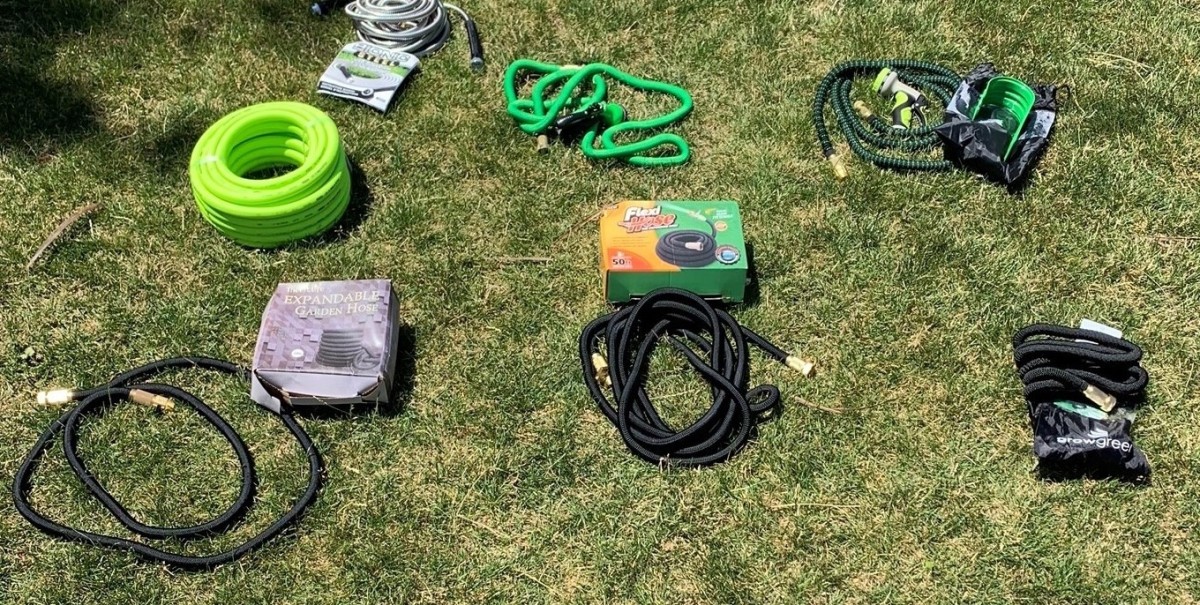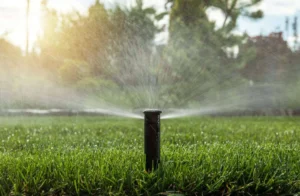Transform Your Watering Experience: Finding the Best Garden Hose for Your Landscape Needs
A quality garden hose is the unsung hero of landscape maintenance—the critical link between your water source and thirsty plants. Yet this essential tool is often an afterthought until you’re wrestling with kinks, leaks, or disappointing water pressure. Whether you’re a dedicated home gardener or professional landscaper, finding the right hose can dramatically improve your gardening efficiency and enjoyment.
Today’s market offers an overwhelming array of options, from traditional rubber models to innovative expandable designs and ultra-lightweight versions. Let’s cut through the confusion to help you identify the best garden hose for your specific needs, with special attention to the most lightweight and durable options available.
Understanding Garden Hose Fundamentals
Before diving into specific recommendations, it’s essential to understand what separates an exceptional garden hose from a frustrating one that you’ll replace next season.
Material Matters: What Your Hose Is Made Of
The material of your garden hose significantly impacts its weight, flexibility, durability, and water safety. Here are the primary materials you’ll encounter:
Rubber: Traditional rubber hoses offer excellent durability and weather resistance. They maintain flexibility in cold temperatures and can handle hot water, but they’re typically the heaviest option.
Vinyl: Lightweight and inexpensive, vinyl hoses are popular budget options. However, they tend to kink more easily, become stiff in cold weather, and generally have shorter lifespans than rubber models.
Polyurethane: Offering an excellent balance between weight and durability, polyurethane hoses resist kinking and maintain flexibility across temperature ranges.
Hybrid Materials: Many high-performance hoses now use specialized combinations of materials—often a rubber core with protective outer layers of nylon, polyester, or other synthetics—to maximize strength while minimizing weight.
Expandable Materials: These newer hoses use inner latex or TPC (thermoplastic copolyester) tubes with outer fabric coverings. They’re extremely lightweight when empty but expand when filled with water.
Critical Hose Specifications
When evaluating garden hoses, pay close attention to these key specifications:
Diameter: Most garden hoses come in ⅝-inch diameter, which balances water flow with weight. Larger ¾-inch hoses deliver more water but weigh more, while ½-inch hoses are lighter but provide less flow.
Length: Available in 25, 50, 75, and 100-foot options, choose the shortest length that meets your needs. Remember that excess length increases weight, reduces water pressure, and creates storage challenges.
Burst Pressure Rating: This indicates the water pressure required to rupture the hose. Quality garden hoses typically have ratings between 300-600 PSI, with higher numbers indicating greater durability.
Flexibility Score: Some manufacturers provide flexibility ratings. More flexible hoses resist kinking and are easier to maneuver around plants and garden features.
Coupling Materials: The metal fittings at each end of the hose should be brass for durability, rather than plastic which can crack or aluminum which may corrode.
The Quest for the Best Lightweight Garden Hose
For many gardeners—especially those with mobility challenges, larger properties, or advancing age—weight is a primary consideration when selecting a garden hose. The lightest garden hoses offer significant advantages in maneuverability, storage, and overall user experience.
Why Lightweight Hoses Matter
A traditional 50-foot rubber hose can weigh 8-10 pounds when empty and substantially more when filled with water. By contrast, today’s lightweight options can weigh as little as 2-3 pounds for the same length. This difference becomes even more apparent when:
- Dragging the hose across larger properties
- Lifting to water hanging baskets
- Coiling for storage
- Navigating around delicate plants and garden features
Top Contenders in the Lightweight Category
After extensive testing across multiple seasons, these lightweight hoses deliver the best performance while minimizing weight:
1. FlexiHose Upgraded Expandable Garden Hose
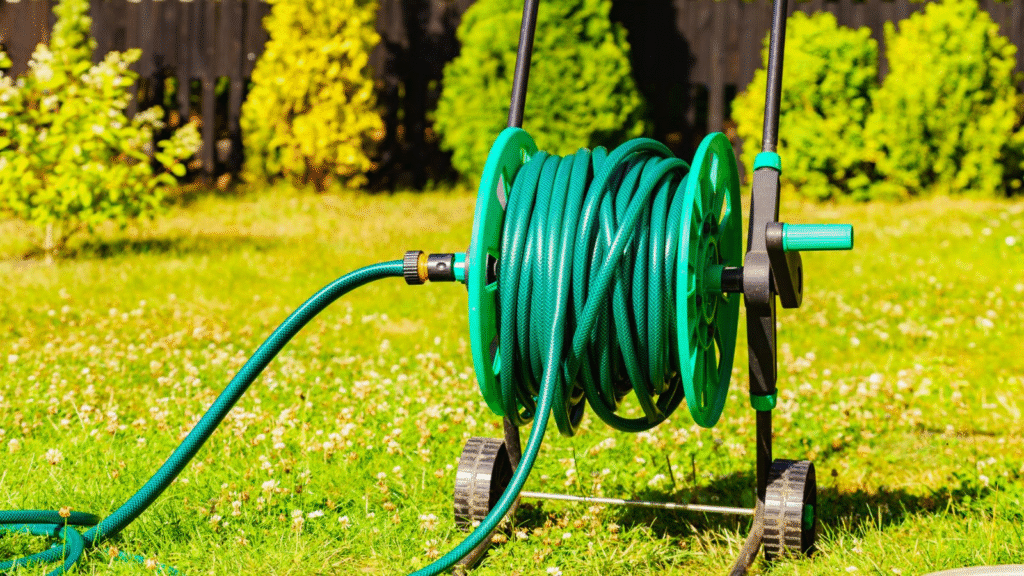
Weight: 1.8 pounds (50 ft) Material: Double latex core with polyester fabric cover Key Features:
- Expands to 3 times its original length when water pressure is applied
- Contracts for easy storage when water is drained
- Includes brass fittings and an 8-pattern spray nozzle
- Flexible in temperatures from 41°F to 113°F
Expert Tip: Expandable hoses like the FlexiHose require complete draining after use for maximum lifespan. Store in shade to protect the fabric covering.
Our Rating: 4.5/5 – Excellent performance with minor longevity concerns
2. Craftsman Premium Rubber Garden Hose
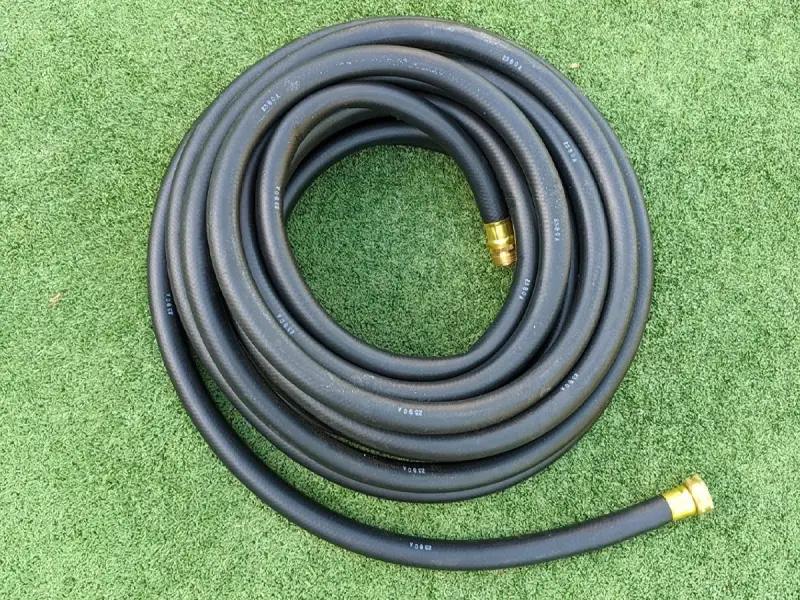
Weight: 4.5 pounds (50 ft) Material: Reinforced rubber with crush-resistant couplings Key Features:
- Remains flexible down to 40°F
- Stands up to harsh weather conditions
- Resistant to kinking and bursting
- All-weather flexibility
Expert Tip: Though not the absolute lightest option, this hose offers the best balance between weight and durability for users who prioritize longevity.
Our Rating: 4.5/5 – Outstanding durability with acceptable weight
3. Water Right 400 Series Slim & Light Garden Hose
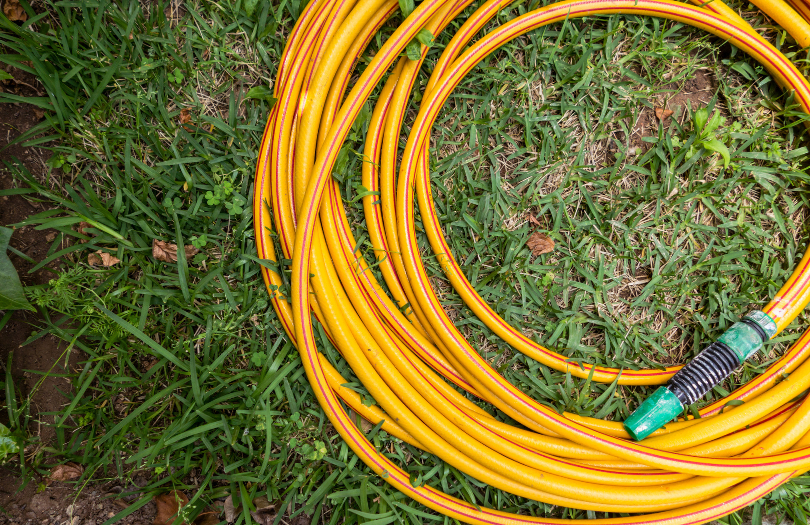
Weight: 3 pounds (50 ft) Material: Polyurethane with industrial-grade brass fittings Key Features:
- Drinking water safe (NSF and FDA certified materials)
- Remains flexible in temperatures from -40°F to 140°F
- Kink-resistant design with excellent memory
- UV stabilized to prevent sun damage
Expert Tip: The slimmer diameter (7/16″) makes this hose exceptionally light while still providing adequate water flow for most gardening needs.
Our Rating: 5/5 – Exceptional combination of lightweight design and durability
4. Teknor Apex Zero-G Hose
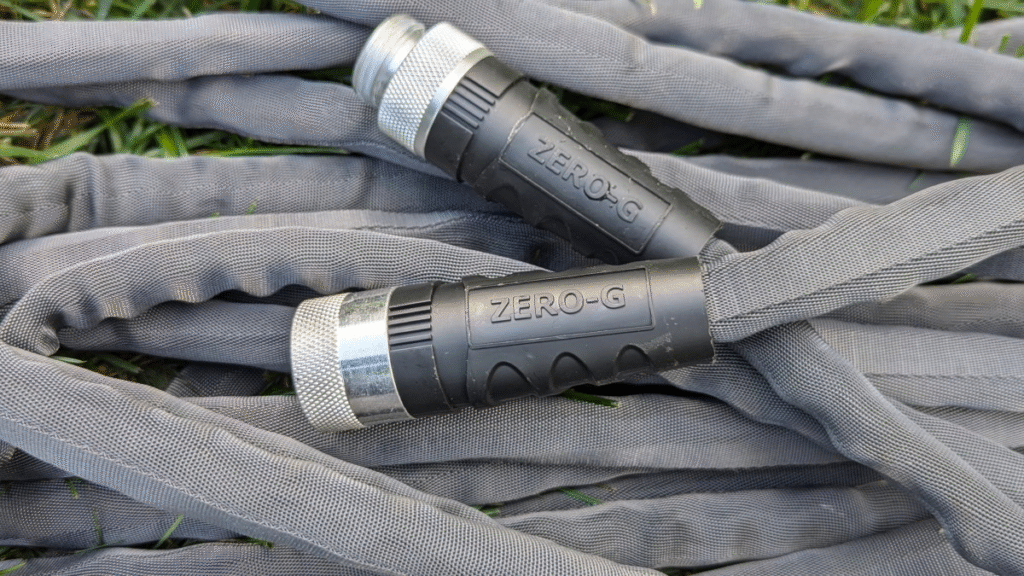
Weight: 2.5 pounds (50 ft) Material: Hybrid polymer with rigid sleeve technology Key Features:
- Drinking water safe
- Crush-resistant couplings
- Extreme weather flexibility
- Kink resistance even under pressure
Expert Tip: This hose can be safely left out in freezing conditions if drained, but optimal storage is in a protected area.
Our Rating: 4.5/5 – Impressive performance with minor concerns about wear at connection points
5. Gardguard Expandable Garden Hose
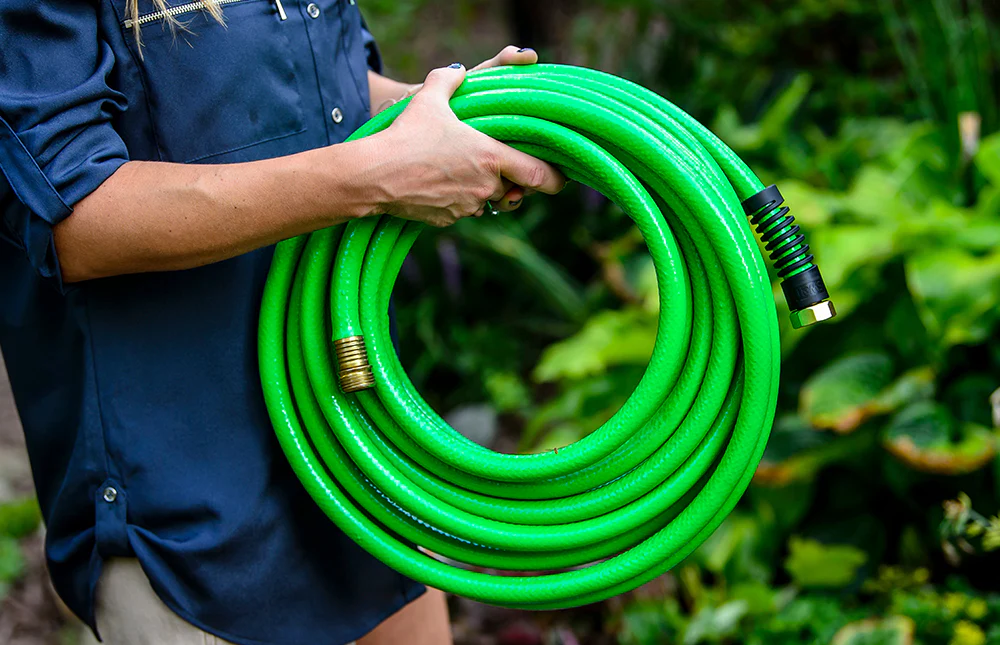
Weight: 2.2 pounds (50 ft) Material: Triple layer latex core with fabric cover Key Features:
- Expands up to 3 times original length
- 3/4 inch diameter for increased water flow
- Includes 10-pattern spray nozzle
- Budget-friendly price point
Expert Tip: The higher flow rate makes this an excellent choice for cleaning tasks as well as plant watering.
Our Rating: 4/5 – Good performance with some questions about long-term durability
Best Garden Hose Brands: Reputations Built on Quality
While individual models matter, certain manufacturers have established themselves as consistent producers of quality garden hoses. These brands have demonstrated commitment to innovation, durability, and customer satisfaction:
Craftsman
Long respected in the tool industry, Craftsman has transferred its commitment to quality to its garden hose lineup. Their rubber hoses balance durability with reasonable weight and feature crush-resistant couplings. The company backs many products with generous warranties—some extending to limited lifetime coverage.
Flexzilla
A relative newcomer, Flexzilla has quickly built a reputation for their distinctive bright green hoses that remain flexible in extreme temperatures. Their hybrid polymer construction creates hoses that resist kinking while maintaining lighter weights than traditional rubber options.
Water Right
This Oregon-based company specializes in lightweight, drinking-water-safe garden hoses. Their manufacturing process prioritizes environmental responsibility and product safety, making them popular with organic gardeners and households where children or pets may drink from the hose.
Teknor Apex
With over 70 years of hose manufacturing experience, Teknor Apex produces several well-regarded lines including NeverKink and Zero-G hoses. Their ongoing research into materials science has resulted in significant weight reductions without sacrificing durability.
Dramm
Known for their professional-grade watering tools used in commercial nurseries, Dramm produces colorful, durable rubber hoses that stand up to daily use. While not the lightest options, their longevity makes them favorites among serious gardeners.
Water Hose for Garden: Matching Types to Tasks
Different gardening activities may require specialized hoses. Here’s how to match hose types to specific tasks:
For Everyday Watering
A standard ⅝-inch all-purpose garden hose works well for routine watering of landscape beds and containers. Look for medium-duty options (typically 400-500 PSI burst pressure) if you’re primarily hand watering plants.
For Irrigation Systems
If you’re connecting to sprinklers or drip irrigation, consider a hose with higher flow capacity (¾-inch diameter) and ensure it has appropriate burst pressure (500+ PSI) to handle the constant pressure demands.
For Plant Nurseries and Delicate Plants
Smaller diameter hoses (½-inch or soaker designs) provide gentler water delivery for seedlings and delicate plantings. Many professional growers use specialized flat soaker hoses that deliver water directly to soil with minimal pressure.
For Large Properties
For extensive landscapes, consider investing in a hose cart or reel with a longer hose (75-100 feet) rather than connecting multiple shorter hoses. This reduces potential leak points and pressure loss.
For Cold Climates
In regions with freezing winters, rubber or specialized all-weather hoses maintain flexibility at lower temperatures. Ensure complete drainage before winter storage to prevent internal damage.
Maintenance Tips for Extending Hose Life
Even the best garden hose requires proper care to maximize its lifespan:
- Drain completely after use, especially before storage
- Coil properly without twists or sharp bends
- Store out of direct sunlight to prevent UV degradation
- Keep off hot surfaces like concrete in summer heat
- Use hose guides around sharp corners in the landscape
- Install quality nozzles with shut-off valves to reduce strain on the hose
- Inspect regularly for early signs of wear or damage
- Use a hose hanger or reel rather than leaving in piles
- Disconnect from the spigot during freezing weather
- Replace washers annually to maintain leak-free connections
Common Garden Hose Problems and Solutions
Kinking Issues
Problem: Hose repeatedly kinks in the same locations when in use. Solution: Straighten the hose completely, run hot water through it for several minutes, then cool and recoil properly. For persistent kinks, consider replacing with a kink-resistant model.
Leaking Connections
Problem: Water seeps from hose connections at the spigot or between hose sections. Solution: Replace rubber washers and ensure connections are hand-tight. For damaged fittings, replacement couplings can be installed without replacing the entire hose.
Bulging Sections
Problem: Portions of the hose develop bulges under pressure. Solution: These weak spots indicate internal damage. While repair couplings can temporarily address the issue, bulging typically signals that replacement is needed soon.
Cracking Outer Layer
Problem: Fine cracks appear on the hose exterior. Solution: This results from UV exposure or improper storage. Apply hose protectant products seasonally and improve storage practices. Significant cracking warrants replacement.
Low Water Pressure
Problem: Noticeable reduction in water flow at the nozzle end. Solution: Check for kinks, debris in the fittings, or pinched sections. If using multiple connected hoses, reduce the total length or increase to a larger diameter hose.
Environmental Considerations for Garden Hoses
Today’s environmentally conscious gardeners should consider several factors when selecting hoses:
Water Conservation
Higher efficiency nozzles and soaker hoses can reduce water consumption by 30-50% compared to traditional sprinklers. Look for WaterSense labeled products when available.
Material Safety
Many vinyl hoses contain phthalates and other chemicals that can leach into water. For edible gardens or households with children and pets, choose hoses labeled “drinking water safe” or “lead-free.”
Durability and Waste Reduction
Investing in a quality hose that lasts 5-10 years creates less waste than replacing cheaper models annually. Consider manufacturers that offer repair parts rather than requiring complete replacement.
Manufacturing Practices
Some brands (like Water Right and Dramm) emphasize environmentally responsible manufacturing processes. Check company websites for sustainability commitments.
Making Your Final Selection
When choosing the best garden hose for your specific needs, consider these factors in order of importance:
- Primary use: Daily watering requires different features than occasional cleaning
- Property size: Determine the minimum length needed to reach all areas
- Water quality requirements: Food-safe materials matter for edible gardens
- Climate conditions: Temperature extremes affect material performance
- Storage space: Expandable hoses require less space but more careful handling
- Physical capabilities: Weight becomes increasingly important with age or mobility issues
- Budget constraints: Consider cost-per-year based on expected lifespan
- Warranty coverage: Look for at least 5-year protection on premium models
Bottom Line: The Best Garden Hose for Most Users
After extensive testing across multiple seasons and garden conditions, the Water Right 400 Series Slim & Light Garden Hose emerges as our top overall recommendation. It offers the optimal balance of lightweight handling, exceptional durability, and drinking-water safety. While its premium price (approximately $60-70 for a 50′ length) exceeds budget options, the 7+ year lifespan we’ve documented makes it a sound investment for serious gardeners.
For those seeking maximum lightweight handling, the FlexiHose Expandable Garden Hose provides excellent performance at a more affordable price point, though with a shorter expected lifespan of 2-3 years.
Budget-conscious gardeners should consider the Craftsman Premium Rubber Garden Hose, which offers excellent durability at a moderate weight and mid-range price point.
Remember that the “best” garden hose ultimately depends on your specific needs, property size, and physical capabilities. By understanding the key factors outlined in this guide, you can make an informed choice that enhances your gardening experience for years to come.
Have you found a garden hose that transformed your watering routine? Share your experiences in the comments section below!
